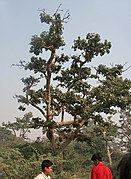Mitragyna parvifolia
| Mitragyna parvifolia | |
|---|---|

| |
| Flower seen in Bengaluru | |
| Scientific classification | |
| Kingdom: | Plantae |
| Clade: | Tracheophytes |
| Clade: | Angiosperms |
| Clade: | Eudicots |
| Clade: | Asterids |
| Order: | Gentianales |
| Family: | Rubiaceae |
| Genus: | Mitragyna |
| Species: | M. parvifolia
|
| Binomial name | |
| Mitragyna parvifolia | |
| Synonyms | |
|
Nauclea parvifolia Roxb. | |
Mitragyna parvifolia is a tree species found in Asia,[2][3] native to India and Sri Lanka. Mitragyna species are used medicinally and for their fine timber throughout the areas where they grow. M. parvifolia reaches heights of 50 feet with a branch spread over 15 feet. The stem is erect and branching. Flowers are yellow and grow in ball-shaped clusters. Leaves are a dark green in color, smooth, rounded in shape, and opposite in growth pattern.[4]
Traditional uses
[edit]Mitragyna parvifolia fresh leaf sap is used by the tribals in treatment of jaundice in the Chenchus, Yerukalas, Yanadis and Sugalis of Gundur District, Andhra Pradesh. Its leaves alleviate pain and swelling, and are used for better healing from wounds and ulcers. Its stem bark is used in treatment of biliousness and muscular pains by the local inhabitant of Tumkur district, Karnataka, India. The tribals of Sonaghati of Sonbhadra district, Uttar Pradesh heal fever by a decoction of the M. parvifolia bark. Valaiyans tribe, population of Sirumalai hills, Madurai district, Western Ghats, Tamil Nadu use stem bark for rheumatic pain. The bark and roots are used to treat fever, colic, muscular pain, burning sensation, poisoning, gynecological disorders, cough, and edema, and as an aphrodisiac. The fruit juice augments the quantities of breast milk in lactating mothers and also works as lactodepurant.[5]
The caterpillars of the commander (Limenitis procris), a brush-footed butterfly, use this species as a food plant.[6]
In religion
[edit]According to ancient literature, this is the 'true Kadam' which is associated with Lord Krishna in Vrindavana, rather than the well-known tree Neolamarckia cadamba. But this is definitely a case of mistaken identity. Neolamarckia cadamba is not found naturally in the hot, dry Vrindavana region. M. parviflora is not only native to the Vrindavana forests but is their dominant tree. Interestingly, M. parviflora are still found almost everywhere in Vrindavana.[7]
Phytochemicals
[edit]Mitragyna parvifolia contains the alkaloids Dihydrocorynantheol, dihydrocorynantheol-N-oxide, akuammigine, akuammigine-N-oxide, 3-isoajmalicine, mitraphylline, isomitraphylline, rhynchophylline, isorhynchophylline, rotundifoline, isorotundifoline, speciophylline-N-oxide, uncarine F, uncarine F-N-oxide, pteropodine, isopteropodine, uncarine D (speciophylline), 16,17-dihydro-17β-hydroxy isomitraphylline, 16,17-dihydro-17β-hydroxy-mitraphylline, and mitragynine.[8][9][10]
Gallery
[edit]-
Trunk at Hodal in Faridabad district of Haryana, India
-
Old tree at Hodal in Faridabad district of Haryana, India
-
Young tree at Hodal in Faridabad district of Haryana, India
References
[edit]- ^ "Mitragyna parvifolia (Roxb.) Korth". The Plant List. Retrieved 17 July 2013.
- ^ "Mitragyna parvifolia". Germplasm Resources Information Network. Agricultural Research Service, United States Department of Agriculture. Retrieved 17 July 2013.
- ^ Sharad Singh Negi, Shgarad Singh (2000). Himalayan Forests and Forestry. Indus Publishing. p. 139. ISBN 978-81-7387-112-2. Retrieved 18 July 2013.
- ^ "Mitragyna parvifolia - Kaim". www.flowersofindia.net. Retrieved 2016-11-03.
- ^ Choudhary, Gajendra Pratap; Jain, Ashutosh Pal (August 2016). "A Review on Mitragyna parvifolia (Roxb.) Korth. – An Indian Medicinal Plant". International Journal of Pharmacy and Pharmaceutical Research. 7 (1): 175–184.
- ^ Kunte, Krushnamegh (2000). Butterflies of Peninsular India. India, A Lifescape. Hyderabad, India: Universities Press. p. 224. ISBN 978-8173713545.
- ^ Phalak, Paresh Prashant. "Gifting Trees...: The True Kadam!". Gifting Trees... Retrieved 2020-05-05.
- ^ Ahmad, Islamudin; Prabowo, Wisnu Cahyo; Arifuddin, Muhammad; Fadraersada, Jaka; Indriyanti, Niken; Herman, Herman; Purwoko, Reza Yuridian; Nainu, Firzan; Rahmadi, Anton; Paramita, Swandari; Kuncoro, Hadi; Mita, Nur; Narsa, Angga Cipta; Prasetya, Fajar; Ibrahim, Arsyik; Rijai, Laode; Alam, Gemini; Mun'im, Abdul; Dej-Adisai, Sukanya (27 January 2022). "Mitragyna Species as Pharmacological Agents: From Abuse to Promising Pharmaceutical Products". Life. 12 (2): 193. Bibcode:2022Life...12..193A. doi:10.3390/life12020193. PMC 8878704. PMID 35207481.
- ^ Badgujar, Vishal; Surana, Sanjay J. (2010). "Anti-Inflammatory and Antinociceptive Activities of Methanol Extract and Alkaloid Rich Fraction of Mitragyna parvifolia Stem-Bark in Animal Models". Journal of Complementary and Integrative Medicine. 7 (1): Article 23. doi:10.2202/1553-3840.1349. Retrieved 14 September 2024.
- ^ Vasmatkar, Pashupat; Dubey, Ashutosh; Tyagi, Bhawna; Baral, Pratibha; Tandon, Shishir; Kadam, Amar (2014). "Antibacterial activity and GC-MS analysis of methanolic extract from stem bark and leaves of Mitragyna parvifolia (Roxb.) Korth" (PDF). Indo American Journal of Pharmaceutical Research. 4 (01): 304–310. Retrieved 14 September 2024.
External links
[edit] Data related to Mitragyna parvifolia at Wikispecies
Data related to Mitragyna parvifolia at Wikispecies Media related to Mitragyna parvifolia at Wikimedia Commons
Media related to Mitragyna parvifolia at Wikimedia Commons












